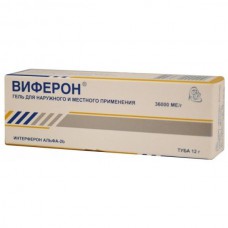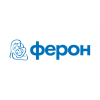Expiration date: 09/2026
The composition and form of issue:
Viferon
Ointment for external and local application 1 g contains:
interferon, human recombinant alpha-2 40000 IU
tocopherol acetate 0.002 g
excipients: anhydrous lanolin, vaseline medical peach butter purified water
the aluminum tube for 12 g in a cardboard box 1 tuba.
Gel for local application of 1 ml contains:
interferon, human recombinant alpha-2 36000 IU
excipients: alpha-tocopherol acetate solution 5% alcoholic solution of methionine with 2% of benzoic acid solution of 0.4% citric acid solution — 10% sodium tetraborate solution with 3% sodium chloride solution — 10% human serum albumin solution 10% glycerine distilled sodium carboxymethylcellulose purified water
the aluminum tubes of 10 ml in a cardboard bundle 1 tuba.
Suppositories for rectal application 1 supp. contains:
interferon, human recombinant alpha-2 150000, 500000, 1000000 or 3000000 IU
excipients: ascorbic acid — 0.015 g (150,000 IU), 0,022 g (500,000 IU, 1000000 IU, 3000000 IU) tocopherol acetate — 0,055 g basis — cocoa butter or solid fat
in a contour acheikova packing PVC/PVC 10 PCs. in cardboard pack 1 pack.
Description pharmaceutical form:
The ointment is yellow or yellowish-white, viscous, homogeneous, with a specific smell of lanolin.
Gel is a homogenous, opaque gel-like mass of white with a grayish tint.
Suppository — a bullet shape, yellowish-white, homogenous. Allowed the heterogeneity of color in the form of marbling and the presence of the cut of funnel-shaped recesses. The diameter of the suppository is not more than 10 mm.
Clinical pharmacology:
BIOLOGICAL PROPERTIES
Interferon, human recombinant alpha-2 possesses antiviral, immunomodulating and antiproliferative properties.
The complex composition of the drugs (ointments, suppositories, gel) causes number of additional effects: in the presence of antioxidants (tocopherol acetate and/or ascorbic acid, benzoic or citric acids, and methionine) increased the specific antiviral activity of recombinant human interferon alpha-2, enhanced by its immunomodulatory effects on T - and B - lymphocytes, normal level of immunoglobulin E, is the reestablishment of the endogenous interferon system. Alpha-tocopherol acetate, ascorbic acid, benzoic acid, citric acid, and also methionine, being highly active antioxidants that possess pronounced anti-inflammatory, membrane stabilizing and regenerating properties.
It is established that in applying the drug Viferon rectal suppositories no side effects when parenteral administration of the interferon, and not formed antibodies neutralizing the antiviral activity of interferon.
Indications:
Ointment: viral (including herpetic) skin lesions and mucous membranes of various localization.
Gel:
- prevention and treatment of children with recurrent stenosing laryngotracheobronchitis and frequently ill with acute respiratory diseases
- treatment of adults with chronic recurrent herpetic infections of different localization.
Suppositories
In the complex therapy:
- various infectious-inflammatory diseases in children, including newborns and premature: SARS, influenza, including bacterial infection, pneumonia (bacterial, viral, chlamydial), meningitis (bacterial, viral), sepsis, intrauterine infection (chlamydia, herpes, CMV infection, enterovirus infection, candidiasis, including visceral, mycoplasmosis)
- chronic viral hepatitis B, C, D in children and adults, including in combination with use of plasmapheresis and hemosorption, chronic viral hepatitis of severe activity and complicated by cirrhosis of the liver
- adults, including pregnant women with urogenital infections (chlamydia, cytomegalovirus infection, ureaplasmosis, trichomoniasis, gardnerellosis, human papillomavirus infection, bacterial vaginosis, recurrent vaginal candidiasis, mycoplasmosis), primary or recurrent herpetic infection of the skin and mucous membranes, localized form, easy and moderate current, including urogenital localization
- influenza and other ARVI and acute respiratory infections, including bacterial infection, in adults.
Contraindications:
Ointment: hypersensitivity to the drug components.
Gel: individual intolerance of the drug, manifested in the form of local allergic reactions.
Suppositories: hypersensitivity to any component of the drug.
Application of pregnancy and breast-feeding:
Ointment: because when external and local application systemic absorption of the interferon low and the drug has action only in the lesion, perhaps the use of the drug Viferon (ointment) during pregnancy and breastfeeding.
Gel: because the local application, systemic absorption of the interferon low and the drug has action only in the lesion, perhaps the use of the drug Viferon (gel) during pregnancy and breastfeeding. Lactation do not use the drug on the breast and nipple in relation to the ability of the drug to form on the surface of the skin long-lasting film.
Suppositories: the drug is approved for use from the 14th week of pregnancy. Has no restrictions for use during lactation.
Side effects:
Ointment have not been identified.
Gel: in rare cases certain highly sensitive individuals may cause local allergic reactions. In such cases, the use of the drug is stopped.
Suppositories: in rare cases allergic reactions (skin rash, itching). These phenomena are reversible and disappear after 72 hours after discontinuation of the drug.
Drug interactions:
Drugs Viferon (ointment, gel and suppositories) are compatible and mix well with all medicinal drugs used in the treatment of viral and other diseases (antibiotics, chemotherapy, corticosteroids).
Method of application and dose:
Ointment, externally and topically. Apply a thin layer on the affected areas 3-4 times a day and gently rubbed in. Duration of treatment — 5-7 days. It is recommended to start treatment at the first signs of skin lesions and mucous membranes (itching, burning, redness). In the treatment of recurrent herpes it is advisable to start treatment in prodromal period or the early signs of relapse.
Gel, topically.
With the goal of preventing acute respiratory infections and recurrent stenosing laryngotracheobronchitis children put a rigid swab on the surface of the tonsils 3 times a day for 3 weeks 2 times a year with the purpose of treatment the drug is prescribed 5 times a day in acute period of the disease (5-7 days), then 3 times a day for the next 3 weeks.
In the treatment of adults with chronic recurrent herpetic infections of different localization the treatment begins in the earliest period from the beginning of the relapse, preferably between precursors. The drug applied to the affected surface from 3 to 7 times a day for 3-5 days. If necessary, the course length increased to 10 days. The number of repeated courses is not limited. The use of the gel allowed on the therapy with other drugs.
When applying the gel on the affected area 30-40 min forms a thin film which make the subsequent application. If desired, the film can peel off or rinse with water.
When applying the gel to the affected mucous surface its pre-dried with a gauze swab.
Suppositories, rectal.
In the complex treatment of various infectious-inflammatory diseases in newborns, including preterm: newborns, including premature babies with a gestational age more than 34 weeks Viferon 150000 IU daily for 1 supp. 2 times a day in 12 hours the Course of treatment — 5 days.
Preterm neonates with a gestational age less than 34 weeks Viferon 150000 IU daily for 1 supp. 3 times a day after 8 hours the Course of treatment — 5 days.
The recommended number of courses in various infectious-inflammatory diseases in children, including newborns and premature: influenza, acute respiratory viral infections, including bacterial infection — 1-2 rate of pneumonia (bacterial, viral, chlamydial) — 1-2 courses of sepsis — 2-3 courses, meningitis — 1-2 courses, herpetic infection — 2 years, enterovirus infection — 1-2 courses, CMV infection — 2-3 courses, mycoplasmosis, candidiasis, including visceral, 2-3 course. The break between courses is 5 days. For clinical treatment with the drug Viferon rectal suppositories can be continued.
In complex therapy of chronic viral hepatitis b, C, D in children and adults
Children with chronic viral hepatitis drug administered in the following age-related doses: up to 6 months — 300000-500000 IU/day from 6 to 12 months — 500,000 IU/day. At the age from 1 year to 7 years — 3000000 IU/m2/day for children older than 7 years of 5,000,000 IU/m2/day. Calculation of drug doses for each patient are produced by multiplying the recommended for the age of dosage on body surface area, calculated according to the nomogram for calculating the body surface area on growth and mass Harford, Terry and'rourke. Divided into 2 injections, dosages are rounded to appropriate suppository. The drug is used 2 times a day in 12 hours the first 10 days daily, then three times a week for 6-12 months. The duration of treatment is determined by clinical efficacy and laboratory parameters.
Children with chronic hepatitis of severe activity and cirrhosis of the liver before conducting plasmapheresis and/or hemosorption shows the use of the drug for 14 days daily 1 supp. 2 times a day 12 hours (children under 7 years — Viferon 150000 IU for children older than 7 years — Viferon 500000 IU).
Adults with chronic viral hepatitis — interferon 3000000 IU 1 supp. 2 times a day 12 hours for 10 days daily, then three times a week for 6-12 months. The duration of treatment is determined by clinical efficacy and laboratory parameters.
In complex therapy in adults, including pregnant women with urogenital infections (chlamydia, cytomegalovirus infection, ureaplasmosis, trichomoniasis, gardnerellosis, human papillomavirus infection, bacterial vaginosis, recurrent vaginal candidiasis, mycoplasmosis, primary or recurrent herpetic infection of the skin and mucous membranes, localized form, easy and moderate current, including urogenital localization)
Adults, when the above infections except herpes — Viferon 500000 IU 1 supp. 2 times a day in 12 hours the Course is 5-10 days. For clinical therapy can be continued, the break between courses — 5 days.
When herpes infection is the interferon of 1,000,000 IU 1 supp. 2 times a day in 12 hours the Course of treatment — 10 days — in recurrent infection. It is recommended to start treatment immediately at the first signs of damage to the skin and mucous membranes (itching, redness, burning). In the treatment of recurrent herpes it is advisable to start treatment in prodromal period or at the beginning of the manifestation of signs of recurrence.
In pregnant women with urogenital infection, including herpes, in the II trimester of pregnancy (from 14 weeks) — Viferon 500000 IU 1 supp. 2 times a day 12 hours for 10 days, then 1 supp. 2 times a day 12 hours for 5 days. Prophylactic course is repeated every 4 weeks. If necessary, it is possible to conduct the treatment prior to giving birth.
In the treatment of influenza and other acute respiratory viral infections and acute respiratory infections, including bacterial infection in adults: Viferon 500000 IU 1 supp. 2 times daily 12 hours daily. The course of treatment — 5-10 days.
Special instructions:
Ointment. Opened the packaging to store in the refrigerator for 14 days.
Gel. Opened the packaging to store in the refrigerator for 10 days.
Age limit for applying the gel do not exist.


